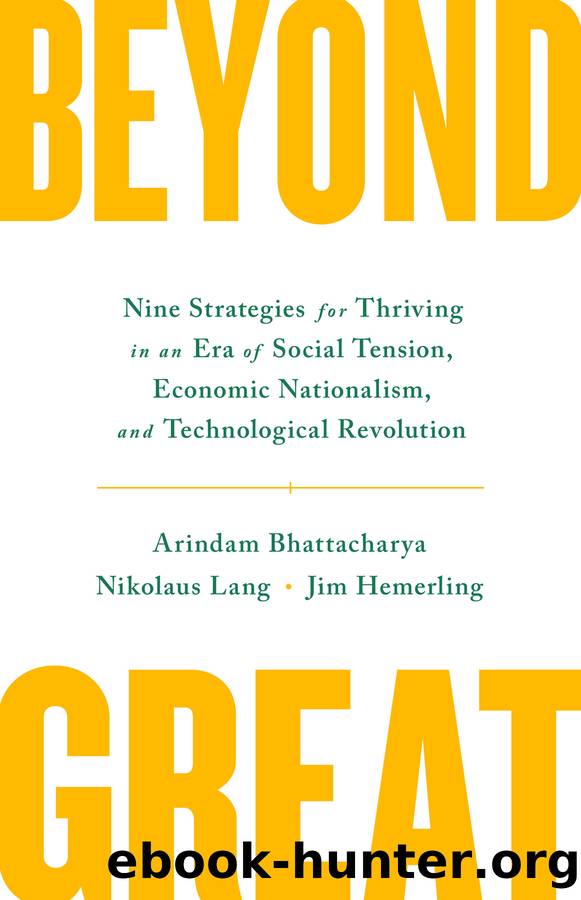Beyond Great by Arindam Bhattacharya

Author:Arindam Bhattacharya [Bhattacharya, Arindam]
Language: eng
Format: epub
Publisher: PublicAffairs
Published: 2020-10-06T00:00:00+00:00
Platform Pathway #3: Collaboratively Create and Amplify Solutions to a Global Customer Base
Global data architectures and cloud-based data platforms allow companies to instantly deploy new solutions in domains and geographies that previously would have been out of reach. A third pathway companies are pursuing to grasp the opportunity generated by global data is to use these platforms to look for patterns in the data, identify potential innovations that might benefit particular customers, develop these solutions, and then quickly spread these solutions to specific groups of customers around the world to unlock exponential value. Such a use of cloud-based platforms amounts to a completely new community-based way of solving problems, one in which experts from a vast array of fields build on one anotherâs capabilities to produce pathbreaking, elegant, and efficient solutions that no one entity working alone could have engineered.
One company that has mobilized a cloud platform to create and disseminate new solutions rapidly and at scale is the French energy company Schneider Electric. Historically, the company has acquired, stored, and used data in a fragmented way, segregating it according to its products and services or the regions in which it operates. It has also treated data as exhaust, capturing it in select instances and analyzing it after the fact to optimize operations. More recently, as value has migrated toward digital solutions, the company has sought to develop a capacity for building and deploying a wide range of solutions quickly and at scale.
The companyâs first step was to create its EcoStruxure platformâan open, scalable, and interoperable IoT architecture that âenables Schneider Electric, its partners and end-user customers to develop scalable and converged IT/OT solutions that deliver innovation at every level to an organization or enterprise.â47 This architecture allowed Schneider Electric to engage with a broad spectrum of participants in its ecosystem and to collect data off devices. Customers could also use software on the platform to better deploy the equipment they had purchasedâwhat the company called âsmart operationsââand to access applications, services, and more from Schneider Electric via the cloud.48 As of 2018, some 650,000 local partners were using the platform, working with Schneider Electric on developing new solutions. In 2018, the company was managing some two million assets around the world on the platform and using EcoStruxure to help customers reduce their CO2 emissions. The company was well on its way to achieving its 2020 goal of reducing emissions by 120 million metric tons.49
In addition to EcoStruxure, Schneider Electric in 2019 launched another platform called Schneider Electric Exchange, billed as âthe worldâs first cross-industry open ecosystem dedicated to solving real-world sustainability and efficiency challenges.â50 âWeâve always had an ecosystem and network of partners,â Schneider Electricâs chief digital officer, Herve Coureil, told us, âwhich has proved to be a very strong asset in the past. As we went digital, we wanted to continue the same and hence built Schneider Electric Exchange, which allows a wide variety of partners to leverage our platforms to collaborate and build solutions for our customers. We didnât want to be at the center of the ecosystem, but to orchestrate it.
Download
This site does not store any files on its server. We only index and link to content provided by other sites. Please contact the content providers to delete copyright contents if any and email us, we'll remove relevant links or contents immediately.
Time Management Made Easy: How to Cultivate New Habits, Improve Productivity and Get Things Done by Joshua Strachan(2384)
The 7 Habits of Highly Effective People by Stephen R. Covey & Sean Covey(2189)
The Concise Laws of Human Nature by Robert Greene(1785)
Doesn't Hurt to Ask by Trey Gowdy(1590)
Primal Leadership by Daniel Goleman(1202)
Hook Point: How to Stand Out in a 3-Second World by Brendan Kane(1151)
HBR's 10 Must Reads 2021 by unknow(1066)
Don't Sweat the Small Stuff...and It's All Small Stuff by Richard Carlson(1059)
Amazon Unbound by Brad Stone(1003)
100 Things Successful People Do by Nigel Cumberland(984)
HBR's 10 Must Reads 2021 by Harvard Business Review(974)
The Job Closer by Steve Dalton(961)
Master of One by Jordan Raynor(960)
Lives of the Stoics by Ryan Holiday & Stephen Hanselman(923)
Declutter Your Mind: A step by step guide to learn to control your thoughts, stop worrying, relieve anxiety and eliminate panic attacks and negative thinking by Mia Chandler(911)
The Power of 100! by Shaun King(894)
Conflicted by Ian Leslie(827)
Coders at Work: Reflections on the craft of programming by Peter Seibel(813)
The Book of Hope by Jane Goodall(791)
